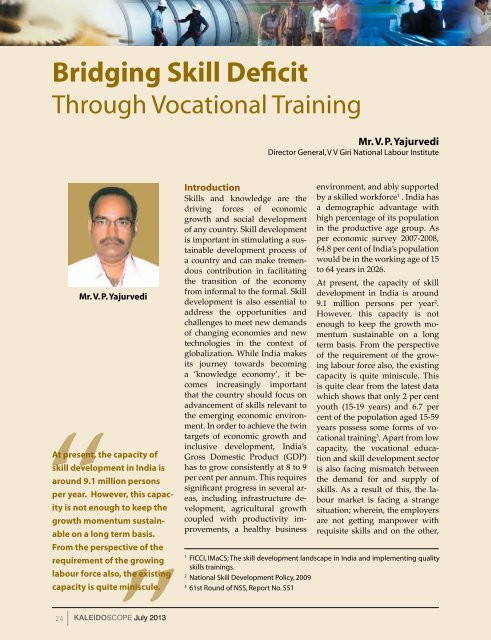Skill Development - scope
Skill Development - scope
Skill Development - scope
You also want an ePaper? Increase the reach of your titles
YUMPU automatically turns print PDFs into web optimized ePapers that Google loves.
Bridging <strong>Skill</strong> Deficit<br />
Through Vocational Training<br />
Mr. V. P. Yajurvedi<br />
Director General, V V Giri National Labour Institute<br />
Mr. V. P. Yajurvedi<br />
At present, the capacity of<br />
skill development in India is<br />
around 9.1 million persons<br />
per year. However, this capacity<br />
is not enough to keep the<br />
growth momentum sustainable<br />
on a long term basis.<br />
From the perspective of the<br />
requirement of the growing<br />
labour force also, the existing<br />
capacity is quite miniscule.<br />
Introduction<br />
<strong>Skill</strong>s and knowledge are the<br />
driving forces of economic<br />
growth and social development<br />
of any country. <strong>Skill</strong> development<br />
is important in stimulating a sustainable<br />
development process of<br />
a country and can make tremendous<br />
contribution in facilitating<br />
the transition of the economy<br />
from informal to the formal. <strong>Skill</strong><br />
development is also essential to<br />
address the opportunities and<br />
challenges to meet new demands<br />
of changing economies and new<br />
technologies in the context of<br />
globalization. While India makes<br />
its journey towards becoming<br />
a ‘knowledge economy’, it becomes<br />
increasingly important<br />
that the country should focus on<br />
advancement of skills relevant to<br />
the emerging economic environment.<br />
In order to achieve the twin<br />
targets of economic growth and<br />
inclusive development, India’s<br />
Gross Domestic Product (GDP)<br />
has to grow consistently at 8 to 9<br />
per cent per annum. This requires<br />
significant progress in several areas,<br />
including infrastructure development,<br />
agricultural growth<br />
coupled with productivity improvements,<br />
a healthy business<br />
environment, and ably supported<br />
by a skilled workforce 1 . India has<br />
a demographic advantage with<br />
high percentage of its population<br />
in the productive age group. As<br />
per economic survey 2007-2008,<br />
64.8 per cent of India’s population<br />
would be in the working age of 15<br />
to 64 years in 2026.<br />
At present, the capacity of skill<br />
development in India is around<br />
9.1 million persons per year 2 .<br />
However, this capacity is not<br />
enough to keep the growth momentum<br />
sustainable on a long<br />
term basis. From the perspective<br />
of the requirement of the growing<br />
labour force also, the existing<br />
capacity is quite miniscule. This<br />
is quite clear from the latest data<br />
which shows that only 2 per cent<br />
youth (15-19 years) and 6.7 per<br />
cent of the population aged 15-59<br />
years possess some forms of vocational<br />
training 3 . Apart from low<br />
capacity, the vocational education<br />
and skill development sector<br />
is also facing mismatch between<br />
the demand for and supply of<br />
skills. As a result of this, the labour<br />
market is facing a strange<br />
situation; wherein, the employers<br />
are not getting manpower with<br />
requisite skills and on the other,<br />
1<br />
FICCI, IMaCS; The skill development landscape in India and implementing quality<br />
skills trainings.<br />
2<br />
National <strong>Skill</strong> <strong>Development</strong> Policy, 2009<br />
3<br />
61st Round of NSS, Report No. 551<br />
24 Kaleido<strong>scope</strong> July 2013













